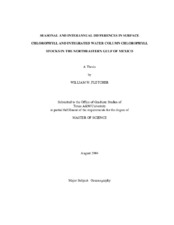| dc.description.abstract | During the Northeastern Gulf of Mexico Chemical and Hydrography study (NEGOM-COH), nine oceanographic cruises were fielded during the spring, summer and fall seasons from November 1997 to August 2000. Surface chlorophyll-? fluorescence, salinity, and temperature data were logged once a minute from the R/V Gyre and subsurface chlorophyll-? fluorescence, salinity, temperature, and nutrients were profiled when the ship stopped to make stations. Each cruise occupied 94-98 stations, partitioned among 11 cross-margin transects of water depths between 10 m to 1000 m.
Overall chlorophyll-? abundance within the study area is forced by the amount of freshwater discharge. Seasonal and interannual differences are largely determined by the monthly mean streamflow for the major rivers within the NEGOM area, particularly the Mississippi River. However, an important forcing function for transport of river water to the outer continental shelf and slope is the periodic presence of anticyclonic slope eddies. Especially when these slope eddies were centered south and east of the Mississippi River delta, they entrained and so redistributed low salinity green water to a wider area within the NEGOM region than could be predicted by mean monthly streamflow alone. The mean surface chlorophyll-? concentrations, and in particular the distribution of relatively high surface chlorophyll-? concentrations off-shelf, were strongly dependent upon entrainment of freshwater by these slope eddies, especially during the three summer cruises. Interannual variability in the summertime entrainment of low salinity green water was driven by summer-to-summer differences in sea surface height (SSH) of the slope eddy(s), and in how far they extended on margin.
Satellite observations of ocean color showed that freshwater entrainment by anticyclonic eddies persisted for a temporal scale of several weeks each summer. Satellite-derived surface chlorophyll-? concentrations were positively correlated with in situ measurements of surface chlorophyll-?, with greatest agreement between satellite and ship measurements of surface chlorophyll-? at concentrations <1.5 mg/m3. Because subsurface chlorophyll-? concentrations were often elevated at depths greater than the first optical depth, satellite measurements of chlorophyll-? concentration generally underestimated integrated chlorophyll-? standing stocks within the euphotic zone. | en |


